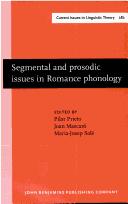| Listing 1 - 3 of 3 |
Sort by
|

ISBN: 9789027247971 Year: 2007 Volume: 282 Publisher: Amsterdam Benjamins
Abstract | Keywords | Export | Availability | Bookmark
 Loading...
Loading...Choose an application
- Reference Manager
- EndNote
- RefWorks (Direct export to RefWorks)
Romance languages --- Langues romanes --- Phonology --- Congresses. --- Phonologie --- Congrès --- Congrès --- Neo-Latin languages --- Italic languages and dialects
Book
ISBN: 9789027248411 9789027273666 9027248419 9027273669 1281145971 9781281145970 9786613776709 661377670X Year: 2012 Publisher: Amserdam ; Philadelphia : John Benjamins Pub. Co.,
Abstract | Keywords | Export | Availability | Bookmark
 Loading...
Loading...Choose an application
- Reference Manager
- EndNote
- RefWorks (Direct export to RefWorks)
The origins of sound change is one of the oldest and most challenging questions in the study of language. The goal of this volume is to examine current approaches to sound change from a variety of theoretical and methodological perspectives, including articulatory variation and modeling, speech perception mechanisms and neurobiological processes, geographical and social variation, and diachronic phonology. This diversity of perspectives contributes to a fruitful cross-fertilization across disciplines and represents an attempt to formulate converging ideas on the factors that lead to sound chan
Grammar, Comparative and general --- Linguistic universals --- Language and languages --- Linguistic change. --- Sociolinguistics. --- Phonologie --- Universaux (Linguistique) --- Variation (Linguistique) --- Changement linguistique --- Sociolinguistique --- Phonology. --- Variation. --- Grammaire --- Universaux (linguistique) --- Variation linguistique --- Linguistic universals. --- Articulatie. --- Diachronische fonologie. --- Geluid. --- Klankverschuiving. --- Grammar, Comparative and general -- Phonology. --- Language and languages -- Variation. --- Linguistic change --- Sociolinguistics --- Languages & Literatures --- Philology & Linguistics --- Phonology --- Variation --- Language and society --- Society and language --- Sociology of language --- Language and culture --- Linguistics --- Sociology --- Integrational linguistics (Oxford school) --- Universals (Linguistics) --- Typology (Linguistics) --- Change, Linguistic --- Language change --- Historical linguistics --- Characterology of speech --- Language diversity --- Language subsystems --- Language variation --- Linguistic diversity --- Variation in language --- Social aspects --- Sociological aspects --- Universals --- Phonologie. --- Philology --- Grammar, Comparative and general Phonology

ISBN: 1282154818 9786612154812 9027292698 9789027292698 9789027247971 9027247978 Year: 2007 Publisher: Philadelphia, PA : John Benjamins Pub.,
Abstract | Keywords | Export | Availability | Bookmark
 Loading...
Loading...Choose an application
- Reference Manager
- EndNote
- RefWorks (Direct export to RefWorks)
This paper explores the concept of linguistic rhythm classes through a series of studies exploiting metrics designed to quantify speech rhythm. We compared the rhythm of 'syllable-timed' French and Spanish with that of 'stress-timed' Dutch and English, finding that rate-normalised metrics of vocalic interval variability (VarcoV and nPVI-V), together with a measure of the balance of vocalic and intervocalic intervals (%V), were the most discriminant between the two rhythm groups. The same metrics were also informative about the adaptation of speakers to rhythmically-similar (Dutch and English) or rhythmically-distinct (Spanish and English) second languages, and showed evidence of rhythmic gradience within accents of British English. Patterns of scores in all studies support the notion that rhythmic typology is not strictly categorical. A perceptual study found VarcoV to be the strongest predictor of the rating of a second language speaker's accent as native or non-native.
Romance languages --- Language and languages. --- Foreign languages --- Languages --- Anthropology --- Communication --- Ethnology --- Information theory --- Meaning (Psychology) --- Philology --- Linguistics --- Neo-Latin languages --- Italic languages and dialects --- Phonology
| Listing 1 - 3 of 3 |
Sort by
|

 Search
Search Feedback
Feedback About
About Help
Help News
News